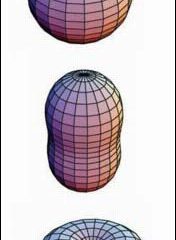This area deals with the fundamental laws and building blocks of nature and how they interact, the properties and the behavior of matter, and research into space and time and their structures.
innovations-report provides in-depth reports and articles on subjects such as astrophysics, laser technologies, nuclear, quantum, particle and solid-state physics, nanotechnologies, planetary research and findings (Mars, Venus) and developments related to the Hubble Telescope.

The belt of high-energy electrons that normally cradles Earth from afar was greatly enhanced and pushed unusually close to our atmosphere during the violent solar activity that occurred in late October, University of Colorado at Boulder researchers say.
The results were obtained from observations by NASA’s Solar, Anomalous, and Magnetospheric Particle Explorer, or SAMPEX satellite, said CU-Boulder’s Laboratory for Atmospheric and Space Physics Director Daniel Baker. An investigato

Although rings around planets like Jupiter, Saturn, Uranus and Neptune are relatively short-lived, new evidence implies that the recycling of orbiting debris can lengthen the lifetime of such rings, according to University of Colorado researchers.
Strong evidence now implies small moons near the giant planets like Saturn and Jupiter are essentially piles of rubble, said Larry Esposito, a professor at CU-Boulder’s Laboratory for Atmospheric and Space Physics. These re-constituted small

The structure of the proton is under the microscope at the U.S. Department of Energy’s Thomas Jefferson National Accelerator Facility (Jefferson Lab) in Newport News, Virginia, where a series of experiments continues to produce unexpected results.
Simple theories of proton structure say that the way electric charge is distributed in the proton is the same as the magnetization distribution. But Jefferson Lab results indicate these distributions are definitely different.
A

Neutron star pairs may merge and give off a burst of gravity waves about six times more often than previously thought, scientists report in today’s issue of the journal Nature [4 December]. If so, the current generation of gravity-wave detectors might be able to register such an event every year or two, rather than about once a decade – the most optimistic prediction until now.
Gravity waves were predicted by Einstein’s general theory of relativity. Astronomers have indirect evidence of thei

Mars Express, ESA’s first probe to Mars, still has some challenges to face.
The spacecraft has successfully come through its first power test after the gigantic solar flare on 28 October.
Since 17 November the on-board software has been ’frozen’ after several updates and the spacecraft is now quietly proceeding to its destination. The next major task, starting on 19 December, will be to safely release the Beagle 2 lander.
Separation
To del

Researchers at Northeastern University today announced that they have been able to demonstrate the unique feature of imaging through a flat lens. Using the phenomenon of negative refraction through a novel photonic crystal, Northeastern physicists observed that a flat slab of such material behaves as a lens and focuses electromagnetic waves at microwave frequencies to produce a real image.
The research, published in tomorrow’s edition of the journal Nature, represents an important advance in